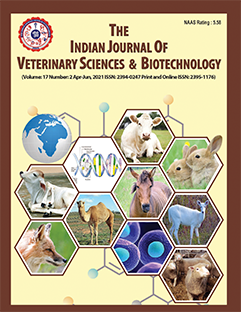Comparative Osteological Biometrics and Morphology of Skull of the Snow Leopard (Panthera uncia) and Leopard (Panthera pardus)
DOI:
https://doi.org/10.48165/ijvsbt.21.5.04Keywords:
Biometrics, Leopard, Snow leopard, SkullAbstract
The study was aimed to analyze the morphological, osteometric and clinically significant landmarks in the skulls of snow leopards and leopards. Skulls were processed through cold water maceration for clean bones, and differentiation was based on morphology and biometrics. Parameters such as length, width, curved length, curved width and cephalic index were measured using scales, Vernier calipers and thread. Results showed that the nasal cavity of the snow leopard was larger than that of the leopard. The angular process in snow leopards was 0.2 cm longer. Leopards had a groove between the orbital rims, while their tympanic bullae were rounder and more distended compared to the snow leopard. The snow leopard’s para-mastoid process formed a hook-like structure (0.5 cm long), and its supraorbital process was more pointed. This research provides species-specific characteristics useful for taxonomic classification, academic purposes, wildlife forensics and assisting wildlife veterinarians in handling clinical cases.
Downloads
References
Christiansen, P. (2006). Sabertooth characters in the clouded leopard (Neofelis nebulosa Griffiths 1821). Journal of Morphology, 267(10), 1186–1198.
Gündemir, O., Duro, S., Jashari, T., Kahvecioglu, O., Demircioglu, İ., & Mehmeti, H. (2020). A study on morphology and morphometric parameters on skull of the Bardhoka autochthonous sheep in Kosovo. Anatomia, Histologia, Embryologia, 49(3), 365–371.
Hemmer, H. (1972). Uncia uncia. Mammalian Species, 20, 1–5.
Kitchener, A., Driscoll, C., & Yamaguchi, N. (2016). What is a snow leopard? Taxonomy, morphology and phylogeny. In Snow Leopards (pp. 3–13). Academic Press. https://doi.org/10.1016/B978-0-12-802213-9.00001-8
McCarthy, T., Mallon, D., Jackson, R., Zahler, P., & McCarthy, K. (2017). Panthera uncia. The IUCN Red List of Threatened Species, 2017, e.T22732A50664030.
McCarthy, T. M., & Chapron, G. (2003). Snow leopard survival strategy (p. 105). International Snow Leopard Trust and Snow Leopard Network.
Ozkan, E., Siddiq, A. B., Kahvecioglu, K. O., Ozturk, M., & Onar, V. (2019). Morphometric analysis of the skulls of domestic cattle (Bos taurus L.) and water buffalo (Bubalus bubalis L.) in Turkey. Turkish Journal of Veterinary & Animal Sciences, 43(4), 532–539.
Prater, S. H. (1971). The book of Indian animals (p. 324). Bombay Natural History Society; Oxford University Press.
Saber, A. S. M., & Gummow, B. (2015). Skull morphometry of the lion (Panthera leo), dog (Canis lupus familiaris) and cat (Felis catus). Journal of Veterinary Anatomy, 8(1), 13–30.
Sayed, R. K., & Hamoda, H. S. (2021). A descriptive morphometric approach to the skull in Red fox (Vulpes vulpes) of Egypt. SVU International Journal of Veterinary Sciences, 4(1), 66–78.
Schauenberg, P. (1969). Contribution à l’étude du Tapir pinchaque, Tapirus pinchaque Roulin 1829. Revue Suisse de Zoologie, 76(8), 211–255.
Sims, M. E. (2012). Cranial morphology of five felids: Acinonyx jubatus, Panthera onca, Panthera pardus, Puma concolor, Uncia uncia. Russian Journal of Theriogenology, 11(2), 157–170.
Sunquist, M., & Sunquist, F. (2002). Wild cats of the world. University of Chicago Press.
Downloads
Published
Issue
Section
License
Copyright (c) 2025 Indian Journal of Veterinary Sciences and Biotechnology

This work is licensed under a Creative Commons Attribution-NonCommercial-NoDerivatives 4.0 International License.




